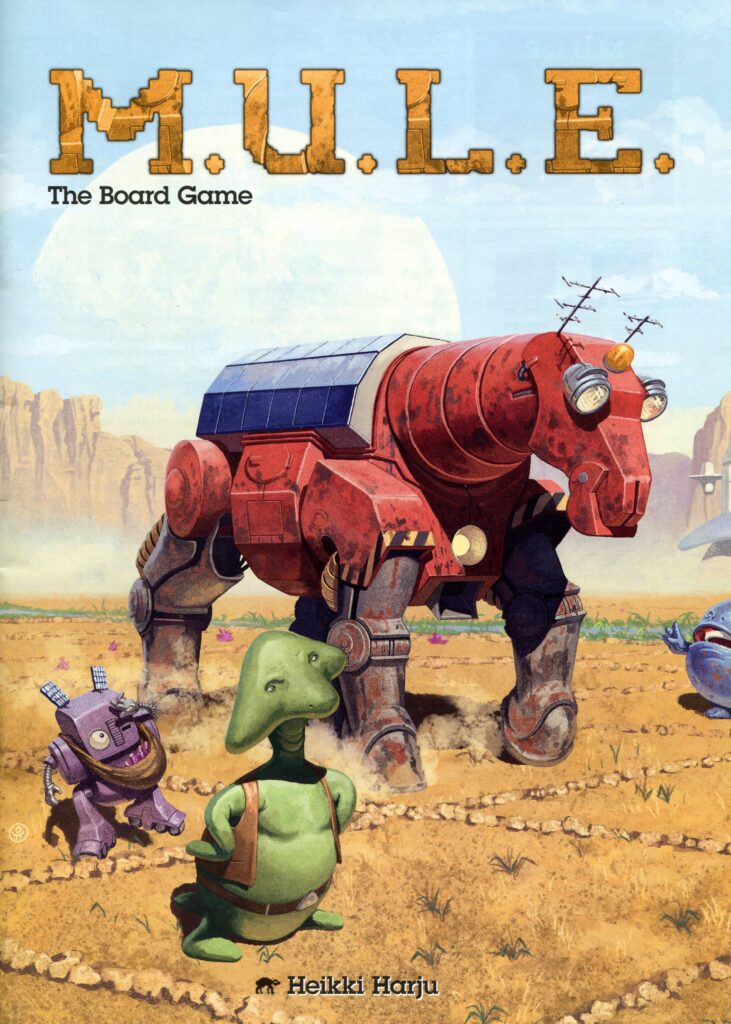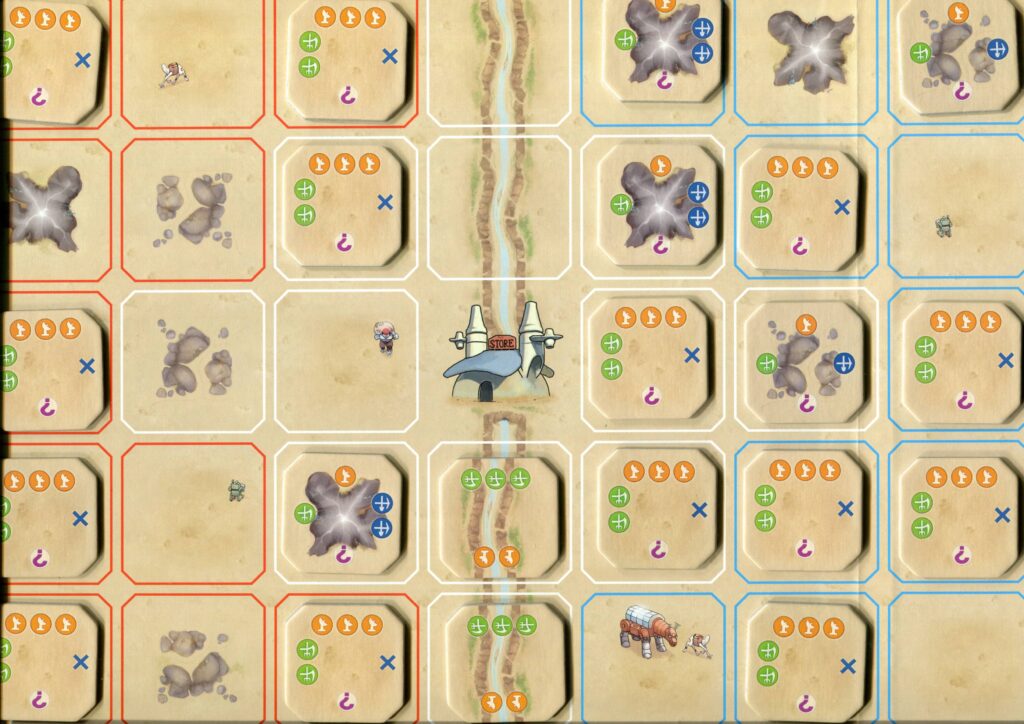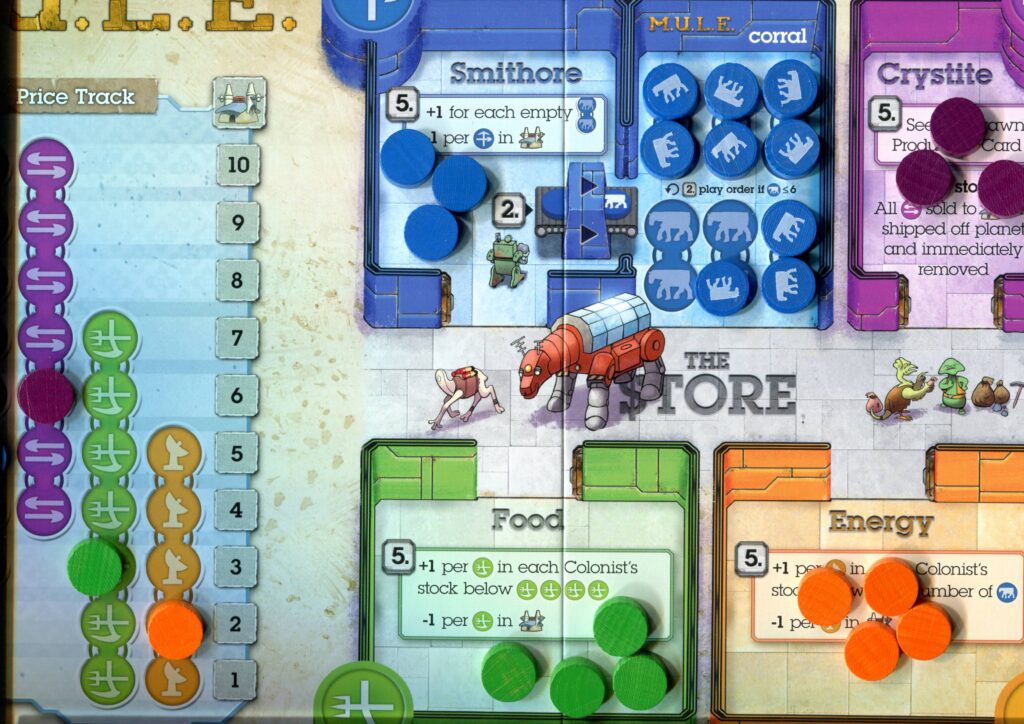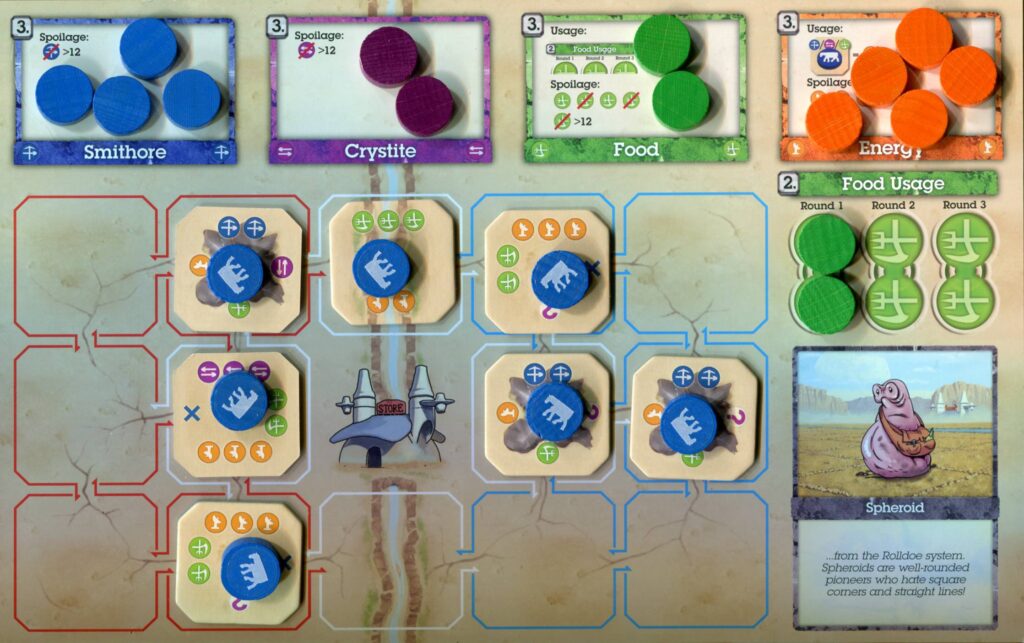There is one officially Ozark Softscape licensed M.U.L.E. board game, and several fan-made designs as “build-your-own-boardgame” projects.
Official board game
Written by World of M.U.L.E. Guest Author: Karawane
Introduction
„M.U.L.E. The Board Game“ is the officially licensed board game version of M.U.L.E. It was developed by Heikki Harju and published in 2015 by Lautapelit.
My first encounter with a M.U.L.E. inspired board game was in 1984. Only one kid in our neighbourhood could run the original M.U.L.E. When that guy was busy the rest of us tried to simulate the gameplay with a self-made board game. At that time, we realised how hard it is to catch the essence of a real-time computer game through a board game. Eventually, our game was little fun to play. Correspondingly, I was very sceptical when the M.U.L.E. board game came out. But I was wrong.
The official board game is very much like the computer game and a lot of fun to play, in certain aspects even more fun than the computer game (I will explain later). It has it all: the typical landscape, the supply and demand chain, the trading, the (exact same) events, the species, the interaction, the economy-of-scale, the collusion, the mountain wampus, and more. It is astonishingly faithful to the computer game, you can even use similar strategies to win. Furthermore, it has a few optional enhancements that work very well.
Insights from the development team
- !NEW! 2021 interview by Karawane: M.U.L.E. The Board Game – 2021 Interview with Heikki Harju
- 2015 interview by Goethe: M.U.L.E. The Board Game coming November 2015 – Interview with creator Heikki Harju
M.U.L.E. The Board Game is said to have been in development as a hobbyist project since the late 1980s. In fact, it has taken more than 10 years and a lot of adjustments to achieve a sophisticated level of gameplay and balance. In the end, the author himself was surprised for making it to production readiness and distribution. You can read further details in both of the above interviews, one conducted by Goethe and one by Karawane.
How to play this game today
Buy the game, get yourself two or three friends, and play it — no additional hardware required.
Gameplay & gameplay comparison with Atari/Commodore M.U.L.E.
The game uses the same basic concepts as the computer game. The players produce, consume and trade commodities, that are food, energy, smithore and crystite. Objective of the game is to become the richest colonist in a given number of months (turns). The secondary objective is to increase the wealth of the colony as a whole. The game can be played with either three or four players. Apparently, there are no computer players to fill up an incomplete party. So, you need a minimum of three real persons to play, at least when sticking to the rules.
A game turn is divided into 7 steps: a land grant (and auction), development, consumption, production, pricing, trading, and events. It is to a great extent the same as the computer game, only with more distinctly segmented actions. This is due to the impracticality of processing real-time calculations in a board-game.
The most obvious difference to the computer game is the management of land. While the main board looks very much like the colony of M.U.L.E. every player has an individual board with an abstract of his or her claims. If a plot is claimed the corresponding counter is taken from the main board to the individual board. The subsequent development of the plots is performed on the individual boards. The main board remains a mere repository of unclaimed plots. The distance of plots to the store is approximated by coloured zones. In the zone closest to the store, actions need less food to be performed. Even though, this mechanism appears different it feels a lot like the computer game.
The development, consumption, production, and pricing are almost exactly as the computer game with the notable difference of the pricing to be done manually. Initially, this seems a tad complicated as there are three different, yet simple formulas to calculate the store‘s prices. If any, this is the unwieldiest step of the game. However, if at least one player knows the formulas by heart (and the others trust him or her), it won‘t impair the flow of the game.
Eventually, all players can trade their commodities. Despite using the same rules of the computer game, the dynamics prove differently here. In my games, most goods were traded through collusion, kind of like in Settlers of Catan, marginalising the store‘s role. This is because players declare as sellers or buyers only after the start of an auction and can offer unrestricted prices at any time to any player, something impossible to do with the collusion mechanism of the computer game. That way, it is easier to achieve good prices for food and energy. In fact, this makes the trading more fun than on the computer.
At the end of each turn, the best player gets to draw a lucky event and give it to another player. In turn, the affected player gets to draw an unlucky event and gives it to yet another player or to the best player. This simple mechanism seems to more effectively balance the game than the computer game‘s choice of events.
Beyond the described, there are a lot of optional rules that let you customise the game the way you like. Some add more strategical elements, like special abilities of each species. Others seem to be a concession to a more exact reproduction of the computer game, but they do not really add any fun. Generally, the option of customising the game is a big advantage over the computer game. Beside the supplied rules, you can easily introduce your own variations. For instance, we once raised the raw material needed for producing M.U.L.E.s from one bar of smithore to two, and the game took a surprising turn and became really challanging. There are home-brew rules available on the internet for playing with two or five players. Both have worked fine in my games.
Reception
The game was well received by a few international magazines and several big boardgame sites. However, it has not earned any official prices, yet. After all, the game seems to be targeted at a limited audience either familiar with the original M.U.L.E. or attracted to cut-throat capitalism. Anyhow, it is easy to play even with children if they qualify for one of the above motivations.
Trivia
<to be done>
Box art gallery:

Board shot gallery:



Fan-made board game projects
to be done
